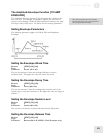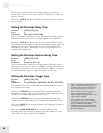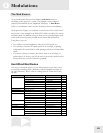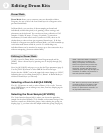
Modulations
8
53
Selecting the LFO Waveform
Buttons: [EDIT] [6-8]
Page: 1
Parameter: Wave (8 choices)
The waveform determines the shape of the LFO. Note that the two
Sawtooth waves, the Square and the Random+ waves are unipolar
(positive-going only) and the rest are bipolar (positive and negative
going):
SINE TRIANGLE SQUARE UP SA W
DOWN SA W RANDOM+- NOISE RANDOM+
Setting the LFO Speed
Buttons: [EDIT] [6-8]
Page: 2
Parameter: Speed (00 to 99)
This controls the speed of the LFO. The higher the value, the faster the
waveform.
Setting the LFO Delay
Buttons: [EDIT] [6-8]
Page: 3
Parameter: Delay (00 to 99)
This sets the amount of time it takes the LFO to fade in from no
modulation to maximum modulation. The higher the value, the more
slowly the LFO fades in.
Setting the Trigger Type
Buttons: [EDIT] [6-8]
Page: 4
Parameter: Trigger
Range: MONO, POLY, KEYMONO, or KEYPOLY
This determines how each voice’s LFO should be started. When playing
multiple voices in a single Sound, each voice has its own LFO. The
Trigger parameter determines whether or not they should be in sync, and
whether or not they can be re-triggered independently from one another.
TIP: The "unipolar" (positive
-
going)
waveshapes tend to have a more noticeable
impact on Filter and Amplitude if they are
routed negatively.
NOTE: Some modulation sources are by
their very nature polyphonic (for example,
velocity or envelope). You will be allowed
to set up such Mod routings when the
Trigger mode is set to MONO, but you won’t
hear any modulation of the LFO speed
occur.
DOWN SAW
TRIANGLE SQUARE UP SAW
SINE
RANDOM+- NOISE RANDOM+


















